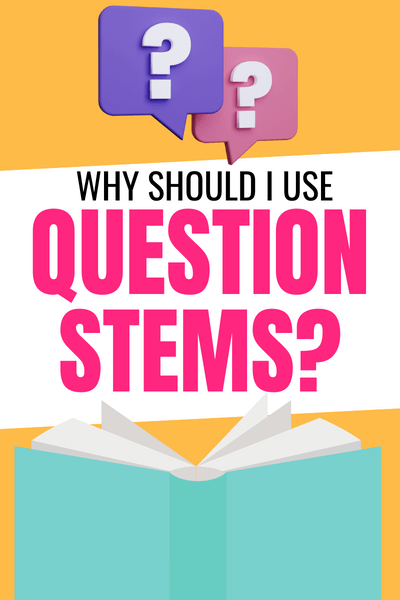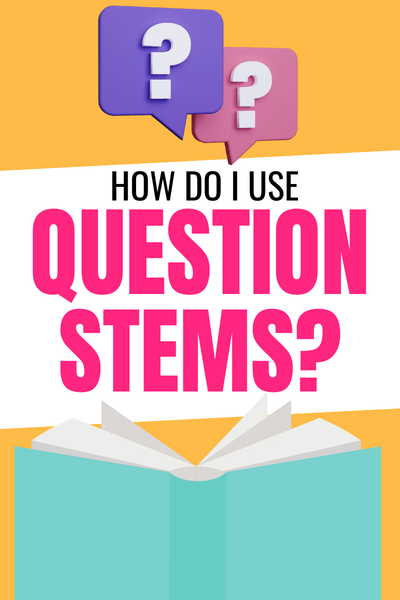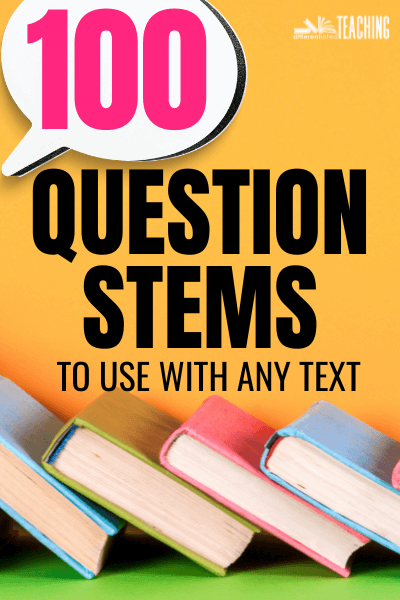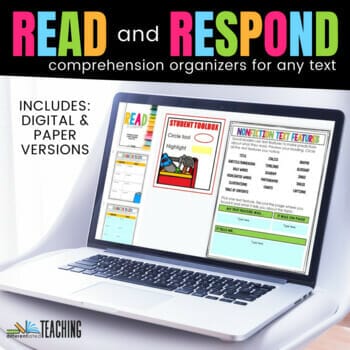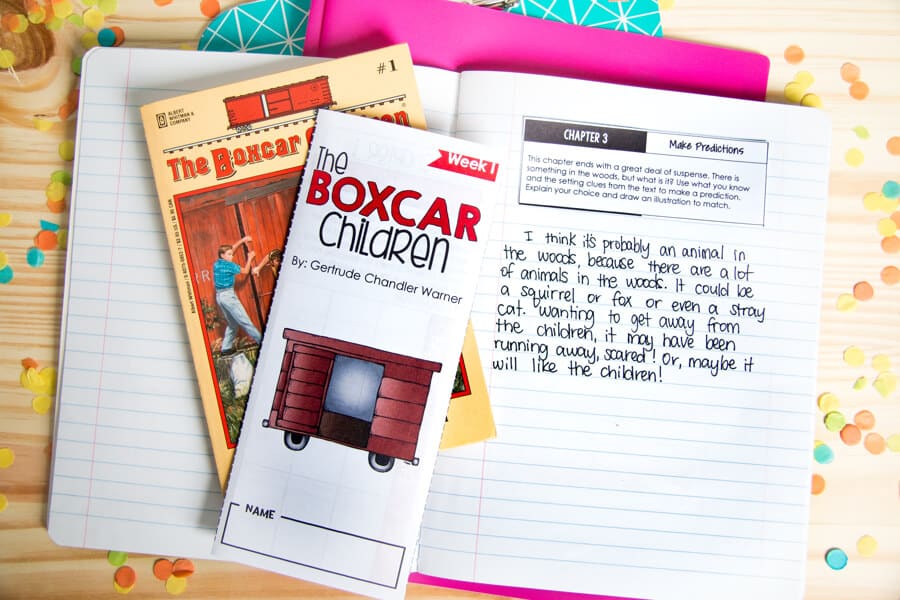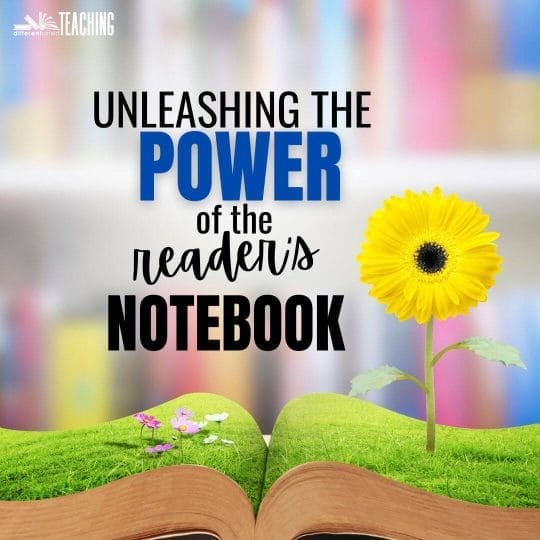125+ Reading Comprehension Question Stems for Any Text
Good reading comprehension instruction starts with strong lesson plans. One of the most important parts of any reading lesson is the questioning that takes place. Whether you’re planning a novel study, reading a picture book, or doing passage practice, well-crafted reading comprehension question stems can help teachers plan high-quality lessons that promote deep understanding and engagement from their students.
In this blog post, I’ll share easy ways to incorporate reading comprehension question stems into your instruction and provide you with a list of options to make lesson planning go a little more smoothly. Let’s get started!
What are question stems?
Question stems are the heart of reading comprehension instruction. They provide teachers with a framework for asking questions that probe student understanding and promote critical thinking.
When used correctly, question stems can ensure all standards are covered and help reading instruction move from surface level to deeper levels of understanding.
This makes them an important tool for fast and effective lesson planning.
Why use stems to support reading comprehension?
There are many reasons why reading comprehension question stems should be an integral part of reading instruction. First, question stems help teachers to focus their questioning. It can be easy to get off track when asking questions during a reading lesson and question stems provide a helpful guide.
Second, question stems encourage students to think more deeply about what they are reading. Good questions should require students to do more than just remember facts or retell the story. Instead, they should be questions that make students think critically about the text and wrestle with complex ideas. There doesn’t have to be a correct answer!
Third, question stems can help reading instruction to be more equitable. By using question stems, teachers can ensure that all students are being asked the same types of questions regardless of the level of their text. This affords them the opportunity to share their thinking and gives exposure to the rich academic language often seen in the question types used on standardized assessments. By utilizing these frameworks throughout the year, you’ll ease the burden of test prep!
When everyone is on the same page, reading instruction can be more effective and engaging for all.
How to use reading comprehension question stems
Now that we know a little bit more about question stems, let’s talk about how to incorporate them into reading instruction. Here are a few easy ways to get started:
– Use question stems as a planning tool. Before reading a text with your students, take some time to brainstorm which question stems would be most appropriate. This will help you to focus your instruction and ensure that all students are being challenged.
– Use question stems as a guide for questioning. During reading, use the question stems as a guide for your questions. This will help you to stay on track and ensure that all students are engaged.
– Use question stems as a way to assess understanding. After reading, use the question stems to assess student understanding. This will give you a good idea of which areas need more attention and which areas your students have mastered.
120+ Comprehension Question Stems to Use with Your Readers
Now that we’ve talked about how to use reading comprehension question stems, it’s time to give you a list of options to use with your students. I’ve organized the stems by type so that you can easily find the ones that will work best for your instruction. Remember, these are just a starting point- feel free to adapt them as needed to meet the needs of your students.
Pre-reading Question Stems
Pre-reading is an important part of engaging students in the reading process. The goal of pre-reading questions is to activate prior knowledge.
In a whole group lesson, these can also help build shared knowledge in preparation for reading a text. These questions should be used before reading to help students engage with the text.
- What do you already know about [this topic]?
- What do you wonder about [this topic]?
- After seeing [the cover/illustrations/title/etc.], what do you think will happen in the story?
- What are your predictions for what will happen in the story?
- Describe the images or illustrations used on the cover. What clues might they give about the text?
- What does the title tell us about the text?
- Who is the author and what other books has he/she written?
- What can we determine about the setting? Is this time/place familiar? If so, what do we already know about it?
- What genre does this text appear to be? How can you tell?
- Is this book fiction or non-fiction? How can you tell?
Story Elements
These questions focus on who, what, when, where, why, and how. They are perfect for helping students to identify story elements and understand the plot of a text. As a result, these questions tend to focus on “right there” comprehension. In other words, for most of these questions, students can find the answer by looking back at a specific location in the text. Therefore, these are considered to be a more basic level of comprehension.
While some of these questions ask students to recall details from the entire passage, others focus on taking text details and reframing them into their own words. The most complex and difficult questions that fall in this category, in my opinion, are the main idea questions. This is because these require students to synthesize separate parts of their reading to create a single statement.
- Who is the main character/protagonist of the story?
- When/Where does the story take place?
- What happened [before/after/when] _________?
- What caused the main character to [do/say] __________?
- How do you know where the story takes place?
- Does this story take place in the past, present or future? How do you know?
- Describe [the main character/setting] using details from the text.
- What words does the author use to describe ________?
- What problem was the main character facing? How did s/he resolve it?
- What important event(s) happened at [the beginning/middle/end] of the story?
- How does [character] act when [event] happens? Explain what s/he says or does.
- What was the [turning point/climax/etc.]?
- What is the main idea of [the passage/paragraph/etc.]?
- Paraphrase the main events.
- According to the text, what caused [character/event] to ______?
- What event in the story caused ______?
Predicting
Making predictions is a great way for students to engage with a text. It allows them to think about what might happen next and why based on their understanding of the plot. They also help keep students focused on the big events and how they are interconnected.
- What do you think will happen next? Why do you think that?
- Based on what has happened so far, what do you think the ending will be?
- Who do you think is the [mystery person/animal/etc.]? What do you think is the purpose of [character/object/event]?
- Is [character] going to be a friend or foe? How can you tell?
- Do you think this story will have a happy ending? Why or why not?
- Based on the setting, what can you predict about the relationship between the main characters?
- Knowing the genre, what do you predict will happen in this story?
Analysis
Analysis questions take things further by requiring students to think critically about the text. These questions are perfect for helping students to make inferences and think beyond “right there” comprehension. To answer these questions, students must pull from their own experiences and what they’ve read in the text.
These questions can be asked more straightforwardly, or you can get creative. However, creatively formatted questions are often more engaging for learners while still requiring them to analyze the text.
Character Analysis
- Based on your reading, what character traits would you use to describe [character]?
- Based on what you know about [character], is this someone who you’d want to be friends with? Why or why not?
- Describe the relationship between [character] and [character].
- How does [character] change throughout the story? What causes these changes to occur?
- How do [character]’s actions at the beginning of the story help you better understand him/her?
- Which statement from the text summarizes the relationship between [character] and [character]?
- How are you similar to [character]? How are you different?
- On page #, the narrator says, “—-“. Based on this statement, how would you describe him/her?
- What does this character contribute to the story?
- How are [character] and [character] similar? In what ways are they different?
- How is this character’s role different from other characters in the story?
- Do you think that this character is [reliable]? Why or why not?
- Knowing this character, what would you do if you were in his/her shoes?
- What does the author mean when s/he says, “—-“? Do you agree with this statement?
- Do you agree with [character]’s decision? Why or why not?
- Did [character] do what you anticipated s/he would to solve [problem]? Explain.
- How does [character] react when faced with [situation]? Compare her/his reaction with your own when you’ve been in similar situations.
Text Analysis
- How does the ending reflect the themes of the story?
- What do you think is the main message or theme of the story?
- Do you think that this text was [informative/engaging/etc.]?
- What point of view is the story told from? How might this impact the reader’s understanding of the plot?
- What context clue(s) best help you figure out the meaning of the word ____?
- How does the author build tension in the passage/story? How did this impact you as a reader?
- Explain what the author meant by _____ using your own/different words.
- What does the author’s choice of words contribute to the tone of the story?
- How does the author’s use of [imagery/metaphors/etc.] help readers understand the text?
- Which detail from the text best supports [claim/statement/idea]?
- Write a summary of the [story/passage/etc.] that incorporates the main ideas concisely.
- The author includes the phrase “—-” to show –
- In paragraph #, what is the meaning of the word [vocabulary word]?
- How does this author show ______?
- What is the meaning of [paragraph/lines]?
- In paragraph #, what is the meaning of [figurative expression]?
- Why is the [first paragraph/last stanza/etc] important to this piece?
- What from the pictures/illustrations helps you understand ____?
- Can you see any similarities between this story and other’s we’ve read?
- What stories have we read with a similar theme to this story?
Inferring/Drawing Conclusions
In order to answer these questions, students need to be able to read between the lines and make inferences based on their understanding of the text. Inference questions can be used while reading or after reading when the author leaves the reader with unanswered questions. However, since inferring is a higher-order skill, many students will need scaffolded support in order to answer these types of questions.
Infer about character, setting, plot
- Based on the story, what can you conclude about [character/setting/problem/etc.]?
- How did [character] feel after [event]?
- Why was [event/character/setting] important to the story?
- What can you infer about the relationship between [character] and [character]?
- If [event] had not happened, how might the story have changed?
- Why does the author compare [character/setting/event/etc.] to ______?
- What motive does [character] have to ______?
- What words in the [paragraph/passage/selection] help you understand how [character] feels about [event]?
- Based on your understanding of the plot, could this story have taken place in [different setting]?
- What does the narrator mean when s/he says, “—-“? How do you know?
- Consider the problem that arose in this passage. Using what you know about them, explain how each of the main characters might solve it.
- What inferences can you make about ____?
- What can you conclude about the relationship between [character] and [character]? How did you reach this conclusion?
- Analyze the advantages and disadvantages of how [character] chose to solve [problem]. Do you think s/he made the right choice?
Infer about author’s craft/tone/message
- What lesson do you think the author was trying to convey through this [story/passage]?
- How might the tone of the passage change if the author was ______?
- Why did the author choose to include ______ in this story? How does it impact the reader’s understanding/experience?
- What theme(s) are incorporated into this [story/passage]?
- How might the tone of the passage change if the author was ______?
- What can you tell about the narrator as you reached the end of the story?
- Based on your understanding of the text, the author draws the comparison between ______ and _____ in order to help the reader do what?
- How does the ending of the [story/passage] reflect its themes?
- What is the author trying to convey? Explain using text evidence.
Author’s Craft
Asking students to examine the author’s craft is helpful both to their experience as readers and writers. When students spend time exploring and analyzing the author’s craft they can better understand the nuances of the text and can begin to see how these same skills can be applied to their own writing to improve their craft.
Here are a few of my favorite question stems that encourage students to focus on the author’s craft during reading instruction.
Literary Elements & Text Features
- What was the author’s intent for including ________ in this passage?
- A cliffhanger is used to engage the reader and keep them wanting more. As you finish this chapter, what questions are you left with?
- Why do you think the author chose to end the chapter this way? How does it impact you as a reader?
- Foreshadowing is when an author gives subtle clues that allow a reader to predict what will happen. What clues has the author given in this selection that helped you prepare for future events?
- Examine the author’s use of figurative language in this [chapter/passage/selection]. How did it help you better understand/visualize what was happening?
- Why did the author choose to title this chapter _____? After reading, do you feel this was a good fit?
- How does the author’s use of descriptive language impact your reading experience? How might this story be different if the author chose to forego these details?
- These chapters/paragraphs are all about ____. Why do you think the author chose to include this information? How does it help the reader connect with the story?
- What senses does the author appeal to through the imagery of this [poem/passage/stanza/etc.]?
Characters/Setting/Etc.
- How do the illustrations included in the text help contribute to your understanding?
- What does [vocabulary word] mean? What clues helped you come to that conclusion?
- How does the author organize the selection? Why do you think s/he chose to organize it in this fashion?
- After reading the passage, explain the mood the author is trying to convey.
- The author writes from the perspective of _____. What effect does this have on how the story is told?
- Examine how the author conveys [character]’s feelings about _____. How might you apply a similar style to your own writing?
- Why do you think the author chose to tell this story from a [first person/second person/third person] point of view? How might this story be different if told from a different point of view?
Non-fiction Text Reading Comprehension Question Stems
Nonfiction texts are often more difficult for readers. While they include factual information, it is common to have a more technical vocabulary and less familiar concepts. These question stems can help you support your students while reading nonfiction passages.
Text Features & Elements of Non-Fiction
- What can you tell me about the structure of this text?
- How does the author’s choice to include ____ help contribute to your understanding of the text?
- Based on the text/illustration, what is the meaning of [vocabulary word]?
- According to the passage, what happens after [insert event or step of process]?
- In paragraph #, what is the meaning of the word [vocabulary word]?
- Explain the reason for the section titled ____ in this passage. How does it benefit the reader?
- Why do you think the author chose to include the [photograph/graph/other text feature] on page #? What information can you gather from this?
- Diagram the parts of a _____ according to the article.
Other Non-Fiction Reading Comprehension Question Stems
- How does the author support his/her claims throughout the reading?
- What is the author’s purpose for writing this [text/chapter]?
- How does the author develop his/her argument in this selection?
- What evidence does the author use to support ______?
- Who is providing this information? How might this differ if it were being told from a [first-hand/second-hand] account instead?
- Is this a primary or secondary source? How do you know?
- Is there anything you disagree with the author on?
- What is the main idea of this [section/chapter/passage]?
- What details in the text support the main idea?
- Based on what you’ve read, what are the pros and cons of [topic]?
- Why did the author feel it was important to share ______ with readers?
- What are some [facts you learned/opinions the author shared] in the text?
- Why did the author write this passage?
- What evidence from the article supports the author’s viewpoint that [insert viewpoint]?
- According to the article, what are the steps involved in _____?
- Which sentence from the article supports the idea that ___________?
- Based on what you’ve read, what is the most important thing a reader should know about [topic]?
A meaningful way to guide the discussion
You can use reading comprehension question stems to help plan high-quality reading lessons for your students. By using these question stems, your students will understand fiction and nonfiction texts better. In addition, they’ll be able to extract important information from nonfiction texts, which is a critical skill as they move toward high school.
Reading comprehension question stems can be used to help students analyze texts more deeply and develop an understanding of the author’s purpose and argument. As students become more proficient readers, they can use these question stems to generate their own questions about the text. This will help them become better, more thoughtful readers.
If you’re looking for a way to improve reading comprehension in your classroom, using reading comprehension question stems is a great place to start. By modeling, scaffolding using graphic organizers during class discussions, and through the use of these stems, you can help your students become better, more engaged readers.
Ready to get started? Grab my graphic organizers bundle to use with these question stems in your classroom.



